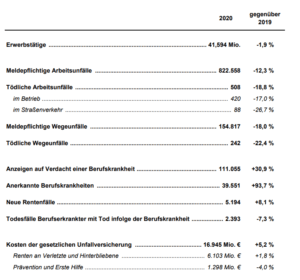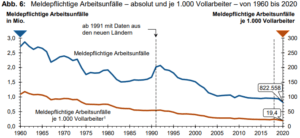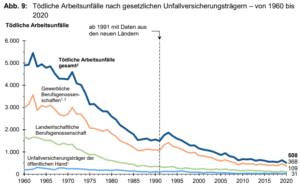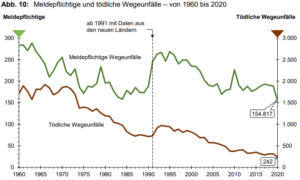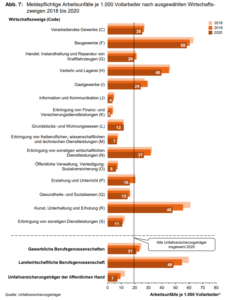On 5 January 2022, the Federal Cabinet adopted the Federal Government's report on the state of occupational safety and health and on the incidence of accidents and occupational diseases in the Federal Republic of Germany in 2020.
This report must be submitted annually by 31 December in accordance with Section 25 (1) of the Social Code (SGB) VII. The reports of the accident insurance institutions and the occupational health and safety authorities of the Länder are included in this report. The report is an update of the previous year and shows the changes in occupational health and safety.
In the reporting year 2020, the Corona pandemic had a significant impact, which means that the data contained in the report can only be compared with previous years to a very limited extent. In order to combat the SARS-CoV-2 coronavirus and prevent its spread, the OSH actors had to take effective and coordinated measures to avoid contact with people and to ensure adequate protection against infection in all areas of life. The individual activities of the OSH authorities and the accident insurance institutions to cope with the pandemic are presented in this year's report. Furthermore, as in every year, the report contains data on employment, occupational accidents and diseases, pensions and incapacity for work.
With the population continuing to rise slightly (82.2 million; +0.4 million), the number of people in employment is slightly lower than in the previous year (-0.8 million) at 41.6 million. The part-time employment rate continued to rise, now totalling 30.0 %, but remains very unequally distributed between the sexes (women 49.6 %; men 12.0 %).
Due to the pandemic, the year 2020 was characterised by short-time work and temporary company closures. This is clearly reflected in the accident figures, as the working population spent less time at their workplaces or on the way there. This has had a strong impact on the insurance situation in the statutory accident insurance system. In 2020, 12.3 % fewer reportable occupational accidents (2020: 822,588; 2019: 937,456) and 18.0 % fewer reportable commuting accidents (2020: 154,817; 2019: 188,827) occurred. The accident rate per 1,000 full workers for reportable occupational accidents is thus 19.4. The figures for fatal occupational and commuting accidents are also about one fifth lower than in the previous year. Similar developments can be seen in the number of accidents involving schoolchildren as a result of the prolonged school closures.
For workers in health care, welfare and laboratories, as well as for workers who are similarly exposed to a risk of infection in their work, recognition of COVID-19 as an occupational disease is possible. This is clearly reflected in the number of reports of suspected occupational diseases (111,055; +30.9 %) and the number of cases recognised (39,551; +93.7 %). This development is even more evident when looking at the figures for infectious diseases (BK No. 3101), which are many times higher than in the previous year with 33,595 (2019: 1,898) reports and 18,959 (2019: 782) recognitions. There is a slight decrease in "deaths of occupationally ill persons with death as a result of the occupational disease" (2,393; -188), although the proportion of deaths caused by asbestos-containing dusts remains very high (64.6 %). In the incapacity for work data, the average duration of an incapacity for work of 13.8 days is significantly higher than in the previous year (12.0). This ratio increases significantly with age: While employed persons aged 15 to under 20 are ill for an average of 6 days per case of incapacity to work, the figure for those over 65 is 27 days per case. The estimate of the economic costs of incapacity to work is about the same as the previous year, at € 87 billion in lost production costs and € 144 billion in lost gross value added.
In the joint annual activity report of the occupational health and safety authorities of the Länder, it was stated, among other things, that in order to improve safety and health protection in companies, the supervisory services must be strengthened and the number of company inspections according to common standards must be increased.
As can be seen from the graphs, the highest number of notifiable occupational accidents was again recorded in the construction industry in 2020, with 58 occupational accidents per 1,000 full-time workers. To make construction even safer for everyone involved in the future, the MuP Group not only examines work processes and procedures in terms of their professional and technical suitability during the planning phase, but also plans the necessary protective measures and procedures right from the start. Engineering for a better tomorrow!
The following figures are taken from the current report for 2020:
Due to a change in the recording of working hours from 2018 and of insurance relationships from 2019 with commercial employers' liability insurance associations and public-sector accident insurance institutions, full-worker figures and working hours, as well as accident rates based on these figures, are also not comparable with previous years. This results in significant changes in individual areas.
In 2016, the Post and Telecommunications Accident Insurance Fund (formerly the public sector accident insurance institution) merged with the Employer's Liability Insurance Association for Transport and the Transport Industry (commercial employers' liability insurance association) to form the Employer's Liability Insurance Association for Transport, Post-Logistics and Telecommunications (BG Verkehr). The figures presented here for the public-sector accident insurance institutions and the commercial Berufsgenossenschaften have been retroactively adjusted from the year 1973.
2 In 2019, including 84 cases from 2000 to 2005 that could only be taken up after the conclusion of criminal proceedings.
Due to a change in the way insurance relationships are recorded from 2019 onwards by the employers' liability insurance associations and public-sector accident insurance institutions, the number of fulltime workers and hours worked, as well as accident rates based on these figures, are not comparable with previous years. This results in significant changes in individual areas.



